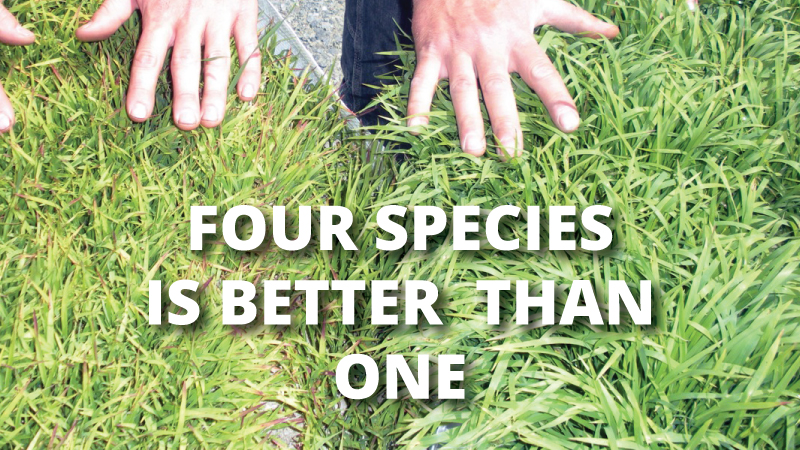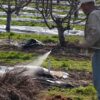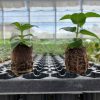
In 1968, one of the most classic rock ‘n roll bands of all time, Three Dog Night, released the song titled “One”. The first line of the song is, “One is the loneliest number that you’ll ever do.” These lyrics were written when the song’s author tried to call a friend and he got a busy signal. The author was alone.
The science behind using a single species of mycorrhizae versus a blend of mycorrhizae species is similar to the message of the song, one (using a single species) is a lonely number.
Several companies on the market offer a single species mycorrhizal inoculant product to their customers. These products are often offered as either a component of a growing mix or are sold separately. The single species most commonly offered is Glomus intraradices (AKA Rhizophagus irregularis or Rhizophagus intraradices). Products that use a single species are limited in the benefits they can offer the grower. The use of multiple mycorrhizal species opens the door to more benefits to the plant, the grower, the retailer, the landscaper, and the home gardener.
Different mycorrhizal species are responsible for different functional benefits to the plant. One host plant can have mycorrhizal associations with a number of different fungal species (even at the same time). The plant turns on and off the mycorrhizal interactions depending on what benefit(s) the mycorrhizae can offer. If the plant has a relationship with only one single species of mycorrhiza, it will only turn on the single species of mycorrhizae when it can benefit from the limited list of benefits the single species can offer. If the plant has relationships with multiple mycorrhizal species, it will turn on the different mycorrhizae more often since the larger offering of mycorrhizal species has a longer list of benefits they can offer to the plant. Simply said, more species of mycorrhizae can offer more potential benefits to the plant.
This point is best illustrated in a case study involving high levels of phosphorous in a growing media. When the phosphorous levels are high, which is often the case in many growing protocols, Glomus intraradices (Rhizophagus irregularis/intraradices) will shut down and stop offering benefits to the plant. When these same plants are offered relationships with the four species consortium of mycorrhizae found in Mycorrhizal Application’s MycoApply products and at the same high phosphorous levels, one or more of the mycorrhizae will continue to function and provide benefits to the plant beyond increasing phosphorous availability.
A typical greenhouse or nursery grows a wide variety of crops and many of these crops have different crop times. An additional benefit of using multiple species of mycorrhizae is that each species of mycorrhizae colonizes the roots at a different speed. If you only use one species of mycorrhizae, you only get one speed of colonization. Using the MycoApply consortium increases the speed of colonization between the plant and the mycorrhizae. Also, each mycorrhizal species colonizes with a plant to a different extent. More colonization by one mycorrhizal species with a plant is not ideal. Colonization by multiple mycorrhizal species offers the plant the most options and the greatest potential for benefits.
Many environmental factors impact a plant during its production in a greenhouse or nursery that can make a difference in the plant’s long-term success. A plant’s rhizosphere is in a state of constant flux. Changes occur in soil moisture, nutrient availability (particularly phosphorus), soil pH, and soil temperature daily and seasonally in the production environment. Different species dominate under different ecological conditions. When a grower uses only one species of mycorrhizae they limit the plant’s ability to respond to these abiotic changes during production. The utilization of a four-species mycorrhizal blend allows plants to respond more positively over a wider range of environmental conditions.
Plants have a lot of internal variables. A plant’s phenology can be a factor in which mycorrhizae species is more attractive to the plant. Since horticulturalists could be treating plants with mycorrhizae during propagation, production, at landscape installation, or in a finished container, it is best to have the maximum number of mycorrhizal benefits to offer the plant if you want a greater chance for success.
Mycorrhizal fungi species complement each other – rarely would you find a single species in nature. Plants in nature recognize that mycorrhizal diversity increases their chance for success.
When selecting a mycorrhizal inoculant product offering to include in your operations, just remember the saying “There is strength in numbers”. The MycoApply product line from Mycorrhizal Application allows you to have “strength in numbers”.
If you have any questions about anything covered in this article, please contact your local Mycorrhizal Applications Representative or call 866-476-7800 or email us at inquiries@mycorrhizae.com.
Article by: Blair Busenbark
Mycorrhizal Applications – Sales and Commercial Marketing Manager
January 15, 2021






